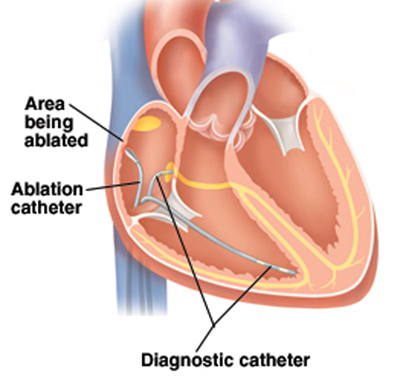Catheter Ablation
Overview

Catheter ablation is a medical procedure used to treat some arrhythmias. An arrhythmia is a problem with the speed or rhythm of the heartbeat.
During catheter ablation, a long, thin, flexible tube is put into a blood vessel in your arm, groin (upper thigh), or neck. This tube is called an ablation catheter. It is then guided to your heart through the blood vessel. A special machine sends energy through the catheter to your heart. This energy finds and destroys small areas of heart tissue where abnormal heartbeats may cause an arrhythmia to start.
The heart’s electrical system controls the speed and rhythm of your heartbeat. With each heartbeat, an electrical signal spreads from the top of the heart to the bottom. As it travels, the electrical signal causes the heart to contract and pump blood.
The process repeats with each new heartbeat. A problem with any part of this process can cause an arrhythmia.
Catheter ablation is one of several treatments for arrhythmia. Your doctor may recommend it if:
• The medicines you take don’t control your arrhythmia
• You can’t tolerate the medicines your doctor has prescribed for your arrhythmia.
• You have certain types of arrhythmia, which can be treated easily with ablation with high success rate and low complication rate.
Though few, catheter ablation has risks. These include but are not limited to bleeding, infection, and pain where the catheter is inserted. More serious problems include blood clots and puncture of the heart. Your doctor will explain the risks to you.
Outlook
Catheter ablation alone doesn’t always restore a normal heart rate and rhythm. Other treatments may need to be used as well. Also, some people who have the procedure may need to have it done again. This can happen when the first procedure doesn’t fully correct the problem.
Acknowledgements
Heart Rhythm Specialists of South Florida gives special thanks to the National Library of Medicine, Wikipedia and National Heart Lung and Blood Institute whose Web sites aided in the research of the patient educational material provided above.






